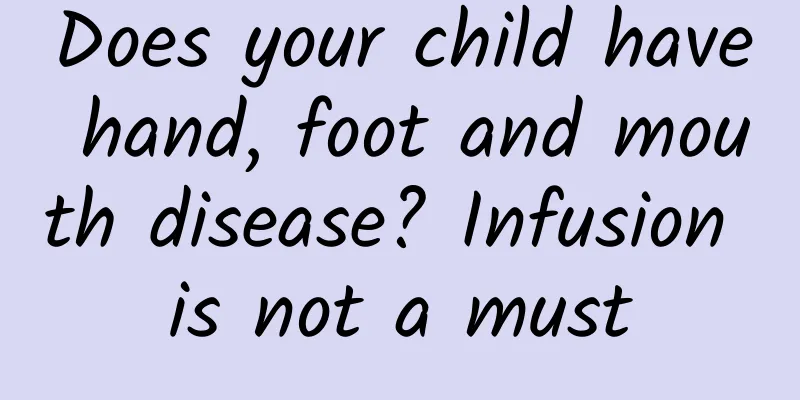Does your child have hand, foot and mouth disease? Infusion is not a must

|
Reading time: 5 minutes, the full text is about 850 words Hand, foot and mouth disease (HFMD) is a common infectious disease in children, causing a lot of anxiety among parents every year. Although most children have mild symptoms, the misconception that "infusion therapy is more effective" is still prevalent. Data show that the intravenous infusion rate for children with mild HFMD in some primary hospitals in my country is as high as 60%, far exceeding the 10% threshold recommended by the WHO. This article combines evidence-based medicine with cutting-edge technology to analyze the hazards of excessive infusion and reshape the logic of scientific nursing. Current misunderstanding: the underlying cause of infusion dependence 1. Cognitive bias: Parents simply associate "infusion = quick recovery" and ignore the self-limiting nature of viral infections. 2. Medical inertia: Some grassroots institutions are limited in their ability to detect pathogens and adopt the conservative approach of "broad-spectrum antiviral antibiotics". 3. Economic driver: The higher medical costs caused by infusion exacerbate unnecessary medical practices. Scientific evidence: There are no specific antiviral drugs for hand, foot and mouth disease pathogens (EV71, CoxA16, etc.), and mild cases only require symptomatic support. Infusion may cause risks such as allergic reactions and electrolyte imbalance, but the rate of severe illness has not been reduced. Cutting-edge technology enables precision care 1. Molecular diagnostic technology: Rapid nucleic acid testing (POCT) can identify pathogen subtypes within 15 minutes and differentiate between mild and severe risks. 2. AI Early Warning System: The dynamic monitoring model based on body temperature, heart rate, and rash progression can predict severe disease progression 48 hours in advance. 3. Microfluidic rehydration technology: Oral rehydration salts (ORS) combined with smart wearable devices can monitor the degree of dehydration in real time and avoid blind infusion. Three cores of scientific nursing 1. Fever management: If the body temperature is less than 38.5℃, physical cooling should be given priority, and ibuprofen/acetaminophen should be used only when necessary. 2. Accurate fluid replenishment: Oral rehydration salt III (osmotic pressure 245mOsm/L) is the first choice for mild dehydration, which is as efficient as intravenous rehydration. 3. Identification of severe cases: Persistent high fever (>3 days), tremors, and shortness of breath require immediate medical attention. Conclusion: Hand, foot and mouth disease care needs to shift from "experience-driven" to "evidence-driven". Through the combination of molecular diagnosis, intelligent monitoring and evidence-based care, more than 30% of unnecessary infusions can be reduced. Parents should establish a scientific understanding of "observation-assessment-tiered intervention", and medical institutions need to strengthen pathogen detection capabilities and guideline implementation. Only by breaking the misunderstanding can the interests of children be maximized. Data support source: 1. National Health Commission's "Guidelines for the Diagnosis and Treatment of Hand, Foot and Mouth Disease (2023 Edition)" 2. The Lancet Regional Health 2022 China Medical Behavior Study 3. Stanford University AI Early Warning Model Paper (2023) 4. WHO Guidelines for the Use of Oral Rehydration Salts 5. China CDC 2023 Hand, Foot and Mouth Disease Surveillance Report |
<<: Both parents are nearsighted, is there any hope for their child's eyes?
Recommend
Acidic environment is more likely to give birth to a daughter
Human body constitution is divided into alkaline ...
Children's eye problems, we answer
Author: Qian Chen Children's Hospital Affilia...
Pain on both sides of lower abdomen after transplantation
After the IVF embryo transfer, women experience l...
I don't have to worry about breast cancer because no one in my family has had it? Is breast cancer a terminal illness? The truth is...
With the improvement of living standards and heal...
Ovarian cystic mass is cancer
Ovarian cystic masses are not necessarily what pe...
Female to male sex reassignment surgery
Sex reassignment surgery has always been very mys...
Amway garlic tablets for gynecological diseases
Amway Nutrilite Garlic Tablets can inhibit the gr...
What to do if you have chest pain and excessive vaginal discharge
Maybe many of our female friends have recently ex...
Acne on face after ovulation
Acne after ovulation is very likely caused by end...
Headache before the period
Menstruation is the biggest dislike for most wome...
Pain in the left pelvic bone of a woman
What is different about pelvic pain is that women...
Should we eat vegetarian food on the first day of the Chinese New Year? What vegetarian dishes should we eat on the first day of the Chinese New Year have good meanings?
We all know that during the Chinese New Year, peo...
What to do if you have abdominal pain after salpingography
Many women with fallopian tube diseases will unde...
Immersive strawberry picking is a big hit during the Spring Festival! Check out this guide to avoid pitfalls
The Spring Festival is approaching, and it is a g...
IDC: AR/VR headset shipments to grow 12.8% in the third quarter of 2024
According to the latest data from IDC, after two ...









